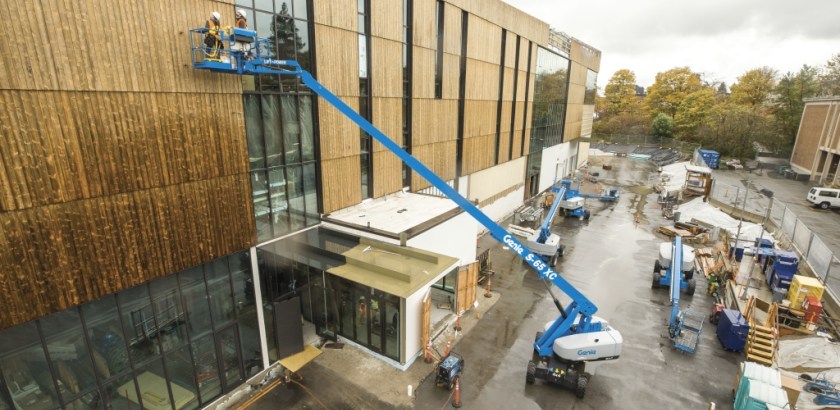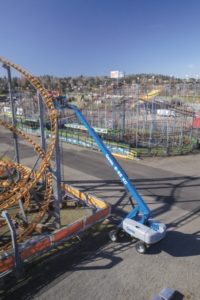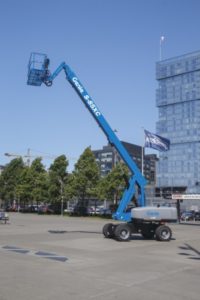Addressing the Challenges of the Upcoming Changes to the ANSI A92 Standards

The upcoming implementation of the new ANSI A92.22 Safe Use and A92.24 Training Standards for Mobile Elevating Work Platforms (MEWPs) in the United States is creating quite a bit of confusion in the industry. The ANSI A92 Standards have always identified the responsibilities for all entities involved with the operation of MEWPs; manufacturer, dealer, owner, user and operator. However, the new standards are placing a huge emphasis on the responsibilities of the user (typically, this is the employer). It is important to understand the implications of that because all of the entities outlined above, with the possible exception of the operator, will fall under the user category at some point in time.
 Although Genie, the manufacturer, produces MEWPs and other equipment, we are also a user (employer) and equipment owner, and we employ many individuals who operate MEWPs on a daily basis during production, testing, loading trucks, etc. Likewise, equipment rental companies will also have the responsibilities of the dealer, owner, user and operator. That is why it is extremely important to understand the requirements outlined in the new standards. Once the standards have been finalized and published, all entities will have one year to be in complete compliance with them.
Although Genie, the manufacturer, produces MEWPs and other equipment, we are also a user (employer) and equipment owner, and we employ many individuals who operate MEWPs on a daily basis during production, testing, loading trucks, etc. Likewise, equipment rental companies will also have the responsibilities of the dealer, owner, user and operator. That is why it is extremely important to understand the requirements outlined in the new standards. Once the standards have been finalized and published, all entities will have one year to be in complete compliance with them.
It is also important to understand that these new standards will affect everyone equally, from the largest construction organizations to the smallest facility management team. Even a small contractor who only occasionally rents a MEWP will be affected. For example, every organization, big or small, that utilizes MEWPs will be required to develop a documented safe use plan that includes a detailed site risk assessment, as well as rescue plans that everyone must be trained on. Anyone who directly supervises a MEWP operator must also receive training. Even the operator will now have the responsibility to provide limited training to any occupants that will be accompanying them in the platform. To begin, the standards will require the user to develop a safe use program specific to MEWPs which must include, but not be limited to:
The user must also develop a written rescue plan that will be carried out in the case of machine breakdown, platform entanglement or fall from platform. The plan must be put in writing and become part of the company's training manual. All occupants must receive training that explains the procedures to follow if they fall and await rescue or witness another worker's fall. This plan must limit the time that a properly restrained worker hangs suspended in the air since the individual(s) may begin to suffer serious bodily injury after 15-20 minutes.
Rescue plans can include self- rescue by the person involved (using a self-rescue harness), assisted rescue by others in the work area (using the ground controls or a second MEWP), or technical rescue by emergency services. Operator training will remain very much as it is now with a few additions. The training must now also cover:
Regardless, all current operators will need to be trained up to the new standards.
Another new requirement in the standards is supervisor training. The user must ensure that all personnel that directly supervise MEWP operators are trained in the following areas:
 When a dealer rents a MEWP to a user, the user absorbs all responsibilities as outlined in this article to ensure that they meet all of the requirements listed in the standard.
When a dealer rents a MEWP to a user, the user absorbs all responsibilities as outlined in this article to ensure that they meet all of the requirements listed in the standard.
Although I stated this at the beginning of this article, it bears repeating: These new standards will affect everyone equally, from the largest construction organizations to the smallest facility management team. The only entity that is not affected by these standards are homeowners and private non-business owners, as they are not subject to OSHA enforcement.
Please keep in mind that, although ANSI standards are voluntary, OSHA often adopts ANSI standards via “incorporation by reference”. When these standards are adopted or incorporated, they become part of the OSHA regulation and therefore compliance is mandatory. Not following the ANSI standards would be considered a violation of OSHA’s “General Duty” clause, which requires employers to keep the workplace “free from recognized hazards”.
In 2016, President Obama signed an act that allowed OSHA to increase their fines for the first time in over a decade with the ability to increase them on an annual basis in order to keep up with inflation. Prior to 2016, the maximum fine for serious and willful violations was $7,000 and $70,000, respectively. In 2016, they increased to $12,471 and $124,709, in 2017 to $12,675 and $126,749, and in January 2018, they increased again to $12,934 and $129,336. They will be paying attention when the standards are published so prepare for the changes now and be ready when the time comes.
It is my opinion that the changes I have outlined will have a very positive effect on the safety of our industry. It should be everyone’s goal to ensure that the men and women who operate MEWPs to earn a living are able to return home to their families at the end of the day in the same shape they were in when they left.
 Although Genie, the manufacturer, produces MEWPs and other equipment, we are also a user (employer) and equipment owner, and we employ many individuals who operate MEWPs on a daily basis during production, testing, loading trucks, etc. Likewise, equipment rental companies will also have the responsibilities of the dealer, owner, user and operator. That is why it is extremely important to understand the requirements outlined in the new standards. Once the standards have been finalized and published, all entities will have one year to be in complete compliance with them.
Although Genie, the manufacturer, produces MEWPs and other equipment, we are also a user (employer) and equipment owner, and we employ many individuals who operate MEWPs on a daily basis during production, testing, loading trucks, etc. Likewise, equipment rental companies will also have the responsibilities of the dealer, owner, user and operator. That is why it is extremely important to understand the requirements outlined in the new standards. Once the standards have been finalized and published, all entities will have one year to be in complete compliance with them.
It is also important to understand that these new standards will affect everyone equally, from the largest construction organizations to the smallest facility management team. Even a small contractor who only occasionally rents a MEWP will be affected. For example, every organization, big or small, that utilizes MEWPs will be required to develop a documented safe use plan that includes a detailed site risk assessment, as well as rescue plans that everyone must be trained on. Anyone who directly supervises a MEWP operator must also receive training. Even the operator will now have the responsibility to provide limited training to any occupants that will be accompanying them in the platform. To begin, the standards will require the user to develop a safe use program specific to MEWPs which must include, but not be limited to:
- Performing a site risk assessment to identify hazards, evaluate risk, develop control measures and communicate with all affected persons,
- The selection, provision and use of a suitable MEWP and associated equipment,
- Access, preparation and maintenance of the site to include an assessment that the support surface is adequate to support the weight of the MEWP,
- MEWP maintenance including inspections and repairs as required,
- Inform the operator of local site requirements and warn and provide the means to protect against identified hazards in the areas where the MEWP will be operated
- Have a trained and qualified supervisor to monitor the performance or the work of the operator to ensure compliance with provisions of the standards,
- Prevention of unauthorized use of the MEWP, and
- Safety of persons not involved in the operation of the MEWP.
- Once the hazards and risks involved in the task have been identified, the procedures and measures required to eliminate or mitigate them must be identified and implemented.
- The risk assessment results are used to plan safe work procedures, including any contingencies required, in carrying out the identified tasks.
- Rescue planning is a necessary component of a risk assessment when working at height. There are situations that require prior planning to ensure a safe and timely rescue. I will talk more about that in a moment.
- The user is responsible for communicating the results of the risk assessment to all parties involved.
The user must also develop a written rescue plan that will be carried out in the case of machine breakdown, platform entanglement or fall from platform. The plan must be put in writing and become part of the company's training manual. All occupants must receive training that explains the procedures to follow if they fall and await rescue or witness another worker's fall. This plan must limit the time that a properly restrained worker hangs suspended in the air since the individual(s) may begin to suffer serious bodily injury after 15-20 minutes.
Rescue plans can include self- rescue by the person involved (using a self-rescue harness), assisted rescue by others in the work area (using the ground controls or a second MEWP), or technical rescue by emergency services. Operator training will remain very much as it is now with a few additions. The training must now also cover:
- proper selection of the correct MEWP for the work to be performed;
- how to perform a workplace risk assessment, including rescue planning, and
- occupant training.
Regardless, all current operators will need to be trained up to the new standards.
Another new requirement in the standards is supervisor training. The user must ensure that all personnel that directly supervise MEWP operators are trained in the following areas:
- Proper selection of the correct MEWP for the work to be performed;
- The rules, regulations and standards that apply to MEWPs, including the provisions for safe use and the work being performed;
- Potential hazards associated with use of MEWPs and the means to protect against identified hazards;
- Knowledge that the manufacturer's operating manuals are an integral part of the equipment and need to be stored properly in the weather resistant compartment on the MEWP.
- the requirement to use fall protection and the location of fall protection anchors;
- Factors including how their actions could affect stability;
- Safe use of any MEWP accessories that they are assigned to use;
- Any site specific work procedures the occupants must follow related to the operation of the MEWP;
- Hazards related to the task at hand and their avoidance;
- Manufacturer’s warnings and instructions; and
- At least one of the occupants must be provided with the knowledge to operate the controls in an emergency where the operator cannot. This is emergency training only and does not constitute operator training.
- Frequent Inspections — When the MEWP is put into service, has been out of service for three months, has been in service for three months or 150 hours, whichever comes first.
- Annual Inspections — Performed no later than 13 months after the previous annual inspection, the annual inspection must be documented on the outside of the MEWP in the form of a decal or plate and must identify the person who performed the inspection and the date the inspection was performed.
 When a dealer rents a MEWP to a user, the user absorbs all responsibilities as outlined in this article to ensure that they meet all of the requirements listed in the standard.
When a dealer rents a MEWP to a user, the user absorbs all responsibilities as outlined in this article to ensure that they meet all of the requirements listed in the standard.
Although I stated this at the beginning of this article, it bears repeating: These new standards will affect everyone equally, from the largest construction organizations to the smallest facility management team. The only entity that is not affected by these standards are homeowners and private non-business owners, as they are not subject to OSHA enforcement.
Please keep in mind that, although ANSI standards are voluntary, OSHA often adopts ANSI standards via “incorporation by reference”. When these standards are adopted or incorporated, they become part of the OSHA regulation and therefore compliance is mandatory. Not following the ANSI standards would be considered a violation of OSHA’s “General Duty” clause, which requires employers to keep the workplace “free from recognized hazards”.
In 2016, President Obama signed an act that allowed OSHA to increase their fines for the first time in over a decade with the ability to increase them on an annual basis in order to keep up with inflation. Prior to 2016, the maximum fine for serious and willful violations was $7,000 and $70,000, respectively. In 2016, they increased to $12,471 and $124,709, in 2017 to $12,675 and $126,749, and in January 2018, they increased again to $12,934 and $129,336. They will be paying attention when the standards are published so prepare for the changes now and be ready when the time comes.
It is my opinion that the changes I have outlined will have a very positive effect on the safety of our industry. It should be everyone’s goal to ensure that the men and women who operate MEWPs to earn a living are able to return home to their families at the end of the day in the same shape they were in when they left.
